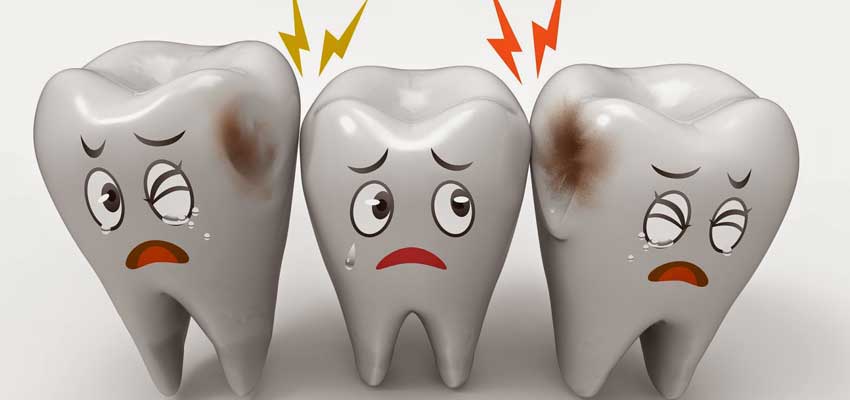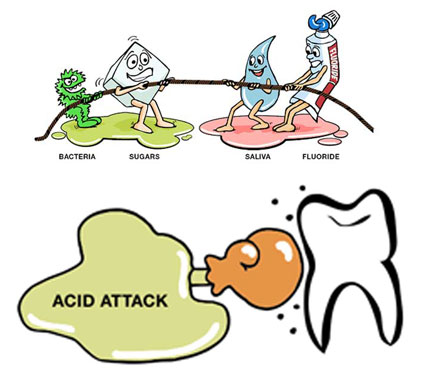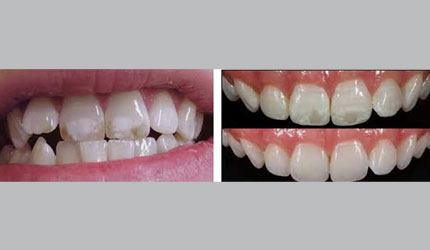
Basically, the stains or discolorations can be classified into three categories, each requiring a different treatment approach.
Have you noticed black or white spots on your teeth while brushing?
Does food get stuck in or between your teeth each time you eat? Especially fibrous foods?
Do you experience pain or sensitivity while eating sweets or drinking cold water or beverages?
Be warned! You may be developing cavities in your teeth!
You probably know that a dental cavity is a hole in a tooth. But did you know that a cavity is the result of the tooth decay process that happens over time? Did you know that you can interrupt and even reverse this process to avoid a cavity?
This web page explains how the tooth decay process starts, how it can be stopped or even reversed to keep you and your children from getting cavities, how to repair the cavities once they are formed.
Food particles and a sticky film comprising of salivary proteins and bacteria (called plaque) are the common soft deposits which stain the teeth. If this plaque is not removed regularly, calcium salts get deposited in the plaque, hardening it into a cement-like substance called tartar or calculus (picture). Plaque and calculus around or on teeth indicates ineffective oral hygiene.
Bad breath or halitosis, is a common occurrence in such patients.
Thorough professional cleaning and polishing would remove these stains.
Our team, Dr Rekha Mahajan, Dr Sanju Mehtre and Lata, can make your teeth stain-free and guide you on how to maintain that bright new smile!
Our mouths are full of bacteria. Hundreds of different types live on our teeth, gums, tongue and other places in our mouths. Some bacteria are helpful. But some can be harmful such as those that play a role in the tooth decay process.
Tooth decay is the result of an infection with certain types of bacteria that use sugars in food to make acids. Over time, these acids can make a cavity in the tooth.

Throughout the day, a tug of war takes place inside our mouths.
On one team are dental plaque—a sticky, colorless film of bacteria—plus foods and drinks that contain sugar or starch (such as milk, bread, cookies, candy, soda, juice, and many others). Whenever we eat or drink something that contains sugar or starch, the bacteria use them to produce acids. These acids begin to eat away at the tooth's hard outer surface, or enamel.
On the other team are the minerals in our saliva (such as calcium and phosphate) plus fluoride from toothpaste, water, and other sources. This team helps enamel repair itself by replacing minerals lost during an "acid attack." Our teeth go through this natural process of losing minerals and regaining minerals all day long.

When a tooth is exposed to acid frequently -- for example, if you eat or drink often, especially foods or drinks containing sugar and starches -- the repeated cycles of acid attacks cause the enamel to continue to lose minerals. A white spot may appear where minerals have been lost. This is a sign of early decay.
Tooth decay can be stopped or reversed at this point. Enamel can repair itself by using minerals from saliva, and fluoride from toothpaste or other sources.
But if the tooth decay process continues, more minerals are lost. Over time, the enamel is weakened and destroyed, forming a cavity. A cavity is permanent damage that a dentist has to repair with a filling.

Fluoride is a mineral that can prevent tooth decay from progressing. It can even reverse, or stop, early tooth decay. Fluoride works to protect teeth. It . . .

Your diet is important in preventing a cavity. Remember . . . every time we eat or drink something that contains sugar or starches, bacteria in our mouth use the sugar and starch to produce acids. These acids begin to eat away at the tooth's enamel. Our saliva can help fight off this acid attack. But if we eat frequently throughout the day -- especially foods and drinks containing sugar and starches -- the repeated acid attacks will win the tug of war, causing the tooth to lose minerals and eventually develop a cavity. That's why it's important to keep an eye on how often you eat as well as what you eat.
Brushing with fluoride toothpaste is important for preventing cavities.
Here's what you should know about brushing :-
On the other team are the minerals in our saliva (such as calcium and phosphate) plus fluoride from toothpaste, water, and other sources. This team helps enamel repair itself by replacing minerals lost during an "acid attack." Our teeth go through this natural process of losing minerals and regaining minerals all day long.

Dental sealants are another good way to help avoid a cavity. Sealants are thin, plastic coatings painted onto the chewing surfaces of the back teeth, or molars. Here's why sealants are helpful: The chewing surfaces of back teeth are rough and uneven because they have small pits and grooves. Food and bacteria can get stuck in the pits and grooves and stay there a long time because toothbrush bristles can't easily brush them away. Sealants cover these surfaces and form a barrier that protects teeth and prevents food and bacteria from getting trapped there.
Since most cavities in children and adolescents develop in the molars (the back teeth), it's best to get these teeth sealed as soon as they come in:
Visit a dentist regularly for cleanings and an examination. During the visit the dentist or hygienist will:
Once a cavity is formed the only way to repair it is by filling the cavity with a suitable restorative material.
There are two basic materials that can be used to fill cavities in the back teeth, silver amalgam and composite resin. For decades, silver amalgam has been used successfully because of its durability, ease of use and affordability. However, currently composite resin is the material of choice for filling cavities. Two main benefits of choosing composite resin over silver amalgam are:
(1) Composites are tooth colored and therefore not noticeable The resin colour closely matches that of a natural tooth, making this option much more aesthetically pleasing.
(2) They are bonded to the cavity using special process and hence require less natural tooth structure to be cut.
When a light cured composite resin filling is properly created and well maintained it can provide the patient with a strong, long lasting and aesthetically pleasing restoration.
Teeth with very deep cavities which have involved the pulp or nerve tissue of the tooth will require root canal treatment (Click here for more information)
Generally just one appointment lasting 30 minutes to one hour should be sufficient for one tooth.
No! Modern techniques in restorative dentistry are not painful. However if the cavity is deep and approaching the nerve of the tooth, we may need to numb the tooth to avoid discomfort. The trick is to catch the cavities in their early stages. This reduces work required, discomfort and cost. So do not ignore spots and cavities even if they don’t hurt!
Good quality fillings will last longer and prevent recurrent decay. Depending upon extent of decay, technique and material used and maintenance, restorations will generally last between 5 to 10 years. Some of our patients have reported with restorations lasting over 25 years! Creating quality restorations can take some more time, effort and charges but will definitely be beneficial in the long run.
At Smilecare, for the past 40 years we have kept ourselves abreast with the latest in our fields and provide long lasting treatment to four generations of patients.
Dr.Uma Mahajan specializes in restoring and saving natural teeth and getting them back into function.
If you are numb following the procedure, you should take care to avoid accidentally biting your lips or cheeks. You should also avoid very hot liquids, until normal sensation returns. The filling will be completely set as soon as the dentist is finished, therefore, you do not have to avoid hard foods or wait for further hardening of the filling material. The tooth may feel sensitive for a few days or even a few weeks after the procedure. This sensitivity normally subsides on its own.Gross neglect leading to extensive caries/decay in teeth

Nerve fibres, the way that pain is sent through the body, aren’t present in tooth enamel. While the acid is attacking the enamel, you can’t feel a thing.
Once the acid has begun to create a cavity and attacks the dentin under the enamel, the nerve fibres begin to send out a message that something is wrong. But by then, you have tooth decay.
That’s why it’s important to have regular, preventive dental check-ups. Don’t wait until it hurts!
Next: What is Root Canal Therapy?
Depending upon the extent ,size, depth, nature of decay our charges for restoring a cavity may range from Rs.850 to Rs.2400. Xray if required will be charged at Rs.200 per Xray.
How does your dentist know when you have a cavity developing between your teeth, or a wisdom tooth beneath the gumline that isn’t growing in properly?
Dental x-rays provide a picture of what’s happening in areas we normally cannot see. Early decay, impacted teeth, abscesses and bone loss from gum disease are all things that dental x-rays reveal.
When the nerve in a tooth is badly damaged, either by an accidental trauma or because of dental decay, sometimes your dentist (or a dental specialist like an Endodontist) will perform Root Canal Therapy (Click here), where a hole is made into the tooth and the damaged nerve (or pulp) is removed with a special file and replaced with a filling material. Usually the tooth is later fitted with a new top called crown to help it remain strong
